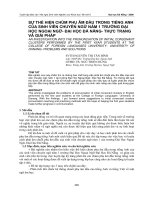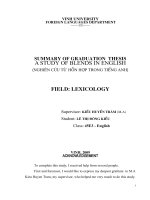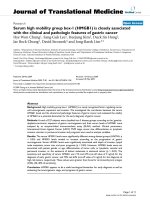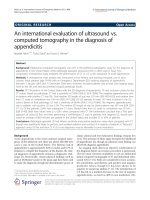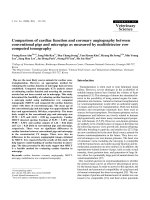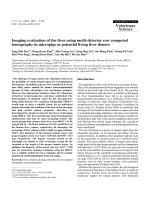Study the value of multidetector row computed tomography in the diagnostic staging of gastric cancer tt tiếng anh
Bạn đang xem bản rút gọn của tài liệu. Xem và tải ngay bản đầy đủ của tài liệu tại đây (435.89 KB, 27 trang )
MINISTRY OF EDUCATION
MINISTRY OF
AND TRAINING
DEFENCE
SCIENTIFIC RESEARCH INSTITUTE OF CLINICAL
MEDICINE 108
**********
NGUYEN VAN SANG
STUDY THE VALUE OF MULTIDETECTOR-ROW
COMPUTED TOMOGRAPHY IN THE
DIAGNOSTIC STAGING OF GASTRIC CANCER
Specialisation
: Image diagnostics
Code
: 627220166
THESIS SUMMARY OF
DOCTORAL DISSERTATION IN MEDICINE
HA NOI - 2019
THESIS IS COMPLETED AT
108 MILITARY CENTRAL HOSPITAL
Science instructors:
1. Do Duc Cuong, Associate Professor, M.D, Ph.D
2. Trieu Trieu Duong, Associate Professor, M.D, Ph.D
Reviewer 1: ......................................................................
Reviewer 2: ......................................................................
Reviewer 3: ......................................................................
The dissertation will be defended in front of the University level
Dissertation Committee at 108 Central Military Hospital. at
.........o’clock …. ..month … .day …. ..year… ..
This thesis can be searched at:
National Library of Vietnam
Library of scientific research institute of clinical medicine 08
1
INTRODUCTION
The rate of patients suffering from of gastric cancer keeps
increasing. That of gastric cancer in Southeast Asia including
Vietnam is 15/100.000. Carcinoma is the most common, which
accounts for 90%. If gastric cancer is diagnosed and treated early, the
survival rate of above 5 years can reach 90%. However, it is often
diagnosed late, so the disease has a high mortality rate. Gastroscopy,
edoscopic ultrasound (EUS) cannot be used to evaluate TNM stages,
which causes difficulties in the treatment process. Multidetector-row
computed tomography (MDCT) can evaluate stages of TNM. In the
world, there are many studies that have evaluated values and
limitations of the MDCT method. To date, there is no final criteria
for predicting lymph node (LN) metastasis among researchers with
using MDCT.
In Vietnam, there are many researches on T and N stages, but
no metastatic LN studies to divide the gastric cancer stages have
been found. Hence, we carried out this topic with two objectives:
1.
Describe the characteristics of gastric cancer images on
multidetector-row computed tomography.
2.
Study the value of multidetector-row computed tomography in
the diagnosis of T and N stages of gastric cancer.
THE NECESSITY OF RESEARCH
Currently, there has been great progress in the diagnosis of gastric
cancer thanks to the strong development of modern facilities
(Gastroscopy, EUS, MDCT). Abdominal MDCT plays a very
important role in helping clinical physicians assess the gastric cancer
2
stages, from which to select appropriate treatments and prognosis. In
the world, there have been many valuable studies using abdominal
MDCT to diagnose gastric cancer. In Vietnam, there are also studies
on gastric cancer, but there is no adequate study on the value of MDCT
in gastric cancer diagnosis, especially the evaluation of metastasis LNs
which is an important factor affecting the prognosis as well as helping
the surgeon make a surgery plan (open surgery or endoscopic surgery,
LN dissection). Therefore, the research is necessary, emerging and has
scientific and practical meanings.
NEW CONTRIBUTION OF THE RESEARCH
Dividing stages of gastric cancer according to AJCC obtained the
following results: overall accuracy: 46.6%, Sn: 30.8 – 62.5%, Sp:
78.3% - 100%, Acc: 70.5% - 87.5%, PPV: 36.4% - 100%, NPV:
84.4% - 94.8%. The following characteristics, which has significant
values in the diagnosis of gastric cancer on MDCT, include tumor
length, tumor position and microscopic classification (The difference is
not statistically significant in dianosing stages by MDCT and
histologic). However, the limitations of
MDCT are tumor
differentiation, invasive tumor, N stage, stages of gastric cancer and
number of metastatic LN /harvested LN (The difference is statistically
significant dianosing stages by MDCT and histologic). Its low
sensitivity of N and AJCC staging presents problems when using it to
make therapeutic decisions, which was shown by this research.
Therefore, improvements in imaging equipment and techniques will
be essential in overcoming the drawbacks of this method, and
rigorous criteria should be developed to diagnose metastatic LNs.
THESIS STRUCTURE
The thesis includes 130 pages; 2 page introduction, 39 page overview,
19 page objects and methods, 30 page results, 37 page discussions, 2 page
conclusions, 01 page recommendation. The thesis has 52 tables, 49
illustrations, 5 charts. 97 references in which Vietnamese has 11.
3
CHAPTER 1: OVERVIEW
1.1 Outline of gastric caner
Among gastric cancers, carcinoma is the most important and
also the most common, accounting for 90-95%. The rate of pyloric
antrum cancer is 50-60%, and the rate of the lesser curvature cancer
is 20-30%. Early gastric cancer is often flat, smaller than 3cm,
discreet and difficult to identify. Advanced gastric cancer includes
4 main forms: polypoid, fungating, ulcerated and diffusely
infiltative. According to Lauren’s classification, microscopic is
divided into 2 types: intestinal type and diffuse type. Besides, the
mixed type includes both intestinal type and diffuse type. TNM
classification according to AJCC 7 is based on tumor invasion,
metastasis LN and distant metastasis.
Table 1.1: T-staging of gastric cancer, AJCC 7th manual
Tumor - T
Primary tumor cannot be assessed
T0
No evidence of primary tumor
Carcinoma in situ: intraepithelial tumor without invasion
Tis
of the lamina propria
Tumor invades the lamina propria, muscularis mucosae,
T1
or submucosa.
T1a Tumor invades the lamina propria or muscularis mucosae
T1b Tumor invades the submucosa
T2
Tumor invades the muscularis propria
T3
Tumor penetrates the subserosal connective tissue.
T4
Tumor invades the serosa or adjacent structures
T4a Tumor invades the serosa
T4b Tumor invades adjacent structures.
TX
4
Table 1.2: N-staging of gastric cancer, AJCC 7th manual
Node - N
NX
N0
N1
N2
N3
Regional lymph node(s) cannot be assessed
No regional lymph node metastasis
Metastasis in 1 to 2 regional lymph nodes
Metastasis in 3 to 6 regional lymph nodes
Metastasis in 7 or more regional lymph nodes
Table 1.4 Stage and prognostic group of gastric cancer, AJCC
7th manual
Stage 0
Stage I A
Stage I B
Stage II A
Stage II B
Stage III A
Stage III B
Stage III C
Stage IV
Tis
T1
T2
T1
T3
T2
T1
T4a
T3
T2
T1
T4a
T3
T2
T4b
T4a
T3
T4b
T4a
Any T
N0
N0
N0
N1
N0
N1
N2
N0
N1
N2
N3
N1
N2
N3
N0;N1
N2
N3
N2; N3
N3
Any N
M0
M0
M0
M0
M0
M0
M0
M0
M0
M0
M0
M0
M0
M0
M0
M0
M0
M0
M0
M1
5
1.2 Diagnostic methods of gastric cancer
1.2.3.1. Gastric X-ray
Double contrast allows us to identify lesions more clearly when
there are abnormal changes in the gastric mucularis. The advantage of
this method is that it is used for patients without gastroscopic
indications. The disadvantage is that the diagnose is more difficult and
it cannot evaluate TNM.
1.2.3.2. Gastroscopy - biopsy.
It is widely applied and causes less catastrophes. Some patients
with pyloric stenosis or pyloric stenosis-causing tumor will cause
many difficulties for gastroscopy and biopsy. Gastroscopy does not
evaluate TNM.
1.2.3.3. Edoscopic ultrasound.
EUS evaluates T invasion well but does not evaluate distant LNs
and distant metastasis.
1.2.3.4. Magnetic resonance imaging
Compared to those using MDCT, there are several studies of
gastric cancer diagnosis using MRI, largely due to the intrinsic
limitations of MRI, such as the susceptibility to bulk motion (e.g.,
respiration, pulsation, and peristalsis), high cost, and lower spatial
resolution compared to MDCT or EUS)
1.2.3.5. PET/CT
PET/CT cannot evaluate metastasis LNs. PET / CT is mainly used
for detecting distant metastases.
1.3. MDCT in the diagnosis of gastric cancer
1.3.2. Image of gastric cancer on MDCT.
The image of gastric cancer on MDCT varies according to the
anatomy. Direct signs can be seen: The gastric wall can be divided
into two or three layers (there may be only one layer in advanced
gastric cancer such as T3 and T4). If the mucosal layer was unevenly
6
thickened and showed abnormal enhancement on MDCT, a mucosal
lesion or gastric cancer would be diagnosed. Early gastric cancer with
ulceration would be considered when focal interruption of mucosa
with adjacent nodularity or thickening was found. If only focal
interruption of the mucosal layer was found, a benign gastric ulcer
would be considered. A lesion was determined to be cancer ous when
the gastric wall showed focal thickening of at least 5-6 mm or greater
or when focal enhancement was seen in the gastric wall.)
Although many radiologists classify metastasis LNs as those with
short axis diameters of 6-8 mm for perigastric LNs, other criteria are
frequently used, including sphericalness and central necrosis,
heterogeneous enhancement, more than , marked enhancement (over
80 or 100 HU), and clustering of more than three LNs. To date, the
accuracy of predicting LNs metastasis has not been satisfactory using
any criteria, and there is still no worldwide consensus for diagnosing
metastatic LNs using MDCT. N-staging of gastric cancer is one of
the inherent limitations of MDCT). The LNs are only identified on
histologic by microscopy to identify metastatic-negative LNs or
metastasis-positive LNs. (metastatic-negative LNs are LNs without
metastatic cells in LNs, metastatic-positive LNs are LNs with
metastatic cells in the LNs)
CHAPTER 2: OBJECT AND METHODOLOGY
2.1. Objects of the research
2.1.1. Location and time of research
The research was conducted at Military Central Hospital 108
from September 2015 to October 2016.
2.1.2. Objects of the research
Patients was diagnosed with gastric cancer, taken with MDCT
16. were identified as epithelial cancer by histology and were under
gastrectomy surgery at 108 Military Central Hospital.
7
2.1.2.1. Criteria to select patients
Diagnosis identifies gastric cancer on gastroscopy and histology.
The patients received radical surgery at 108 Military Central
Hospital. The patients had radical surgery for the first time, not using
chemotherapy, regardless of age and gender.
2.1.2.2. Exclusion criteria
MDCT patients who were not well performed according to
preoperative techniques at 108 Military Central Hospital.
2.2. Methods of research
2.2.1. Research design
This is a cross-sectional descriptive and prospective research in
which there is a comparison among MDCT, surgery and histopathology.
2.2.2. Sample size
With the accuracy of T stage according to author Kim JW and et al
which is 77.2%, error m = 10%. Apply for cross-sectional descriptive
research.
n≥ 68 patients. We have n = 88 patients.
2.2.3. Research tools
MDCT machine with 16 rows of BRIVO CT 385 detectors GE US is located at the Diagnostic imaging Department, in 108 Military
Central Hospital.
Medical record forms are all the same.
2.2.4 Analyzing and processing data
The research data is encoded, imported, processed and analyzed
on computers using SPSS 22.0 medical statistical software.
Using chi square test (χ2) for ratios, Test - T - Student (two
groups), anova (3 groups or more) for quantitative variables. The
difference is statistically significant with p<0.05. Confidence interval
8
of Odds Ratio (OR).
Continuous and quantitative variables are presented as average
values with standard deviation X± SD.
The results of the collection and analysis are presented in the form
of frequency, percentage, average value, used to express the results in
the tables and charts.
Indicators of Sn, Sp, Acc, PPV and NPV are determined by table
setting method.
Calculate kappa coefficients: To find relevance
Calculate sugar ROC: To determine the optimal cutting point.
2.3. Ethics
The topic has been approved by the ethical council of 108
Military Central Hospital
All information of individuals of the research subject is
confidential.
CHAPTER 3. RESULTS
3.1. General features
3.1.1. Age, gender
Table 3.1:Distribution of patients by age and gender
Age group
Male (n,%)
Female (n,%)
Total (n,%)
< 40
01 (50.0)
01 (50.0)
02 (100)
40 - 59
16 (59.3)
11 (40.7)
27 (100)
60 - 79
46 (85.2)
08 (14.8)
54 (100)
≥ 80
02 (40.0)
03 (60.0)
05 (100)
Total
65 (73.9)
23 (26.1)
88 (100)
64.1 ± 10.3
60.9 ± 14.4
63.2 ± 11.5
(34 - 86)
(33 - 84)
(33 - 86)
± SD
(min - max)
p (T-test) = 0.252
9
Comment: The average age in the research was 63.2 ± 11.5 (33 - 86)
years. There is no difference in the average age of male and female,
with p> 0.05
3.1.3 Microscopic classification
Chart 3.2: Lauren’s classification
Comment: Mixed type is the most common (36.4%). Type of
intestinal tye is the least common (30.7%).
3.2. Imaging characteristics of gastric cancer by MDCT
3.2.1. Tumor characteristics.
3.2.1.2. Tumor size
Table 3.4: Length of tumor
Size (d,mm)
n (n = 84)
%
04 ≤ d < 20
13
15.5
20 ≤ d < 40
47
56.0
40 ≤ d< 60
18
21.4
60 ≤ d ≤ 91
06
07.1
± SD (min - max)
34.5 ± 16.9 (4 - 91) mm
Comment: The average length of the tumor diagnosed on MDCT
is 34.5 ± 16.9 (4 - 91) mm.
10
Table 3.5: Thickness of the tumor
Size (d,mm)
n (n = 88)
%
02 ≤ d ≤ 10
46
52.3
10
20
22.7
15 < d ≤ 20
14
15.9
20 < d ≤ 30
08
09.1
± SD (min - max)
11.5 ± 6.1 (2 - 30) mm
Comment: The average thickness of the tumor diagnosed on
MDCT is 11.5 ± 6.1 (2 - 30) mm.
3.2.1.3. Attenuation value and tumor differentiation
Table 3.6: Attenuation value and tumor differentiation
Attribute
n
%
Tumor
Undifferentiated
71
80.7
differentiation
Differentiated
17
19.3
± SD (min max) HU
Unenhanced phase
Portal venous phase
49.8 ± 10.1 (31 - 77)
131.9 ± 20.7 (90-180)
Comment: The majority of the tumors is undifferentiated (80.7%).
The average attenuation value of the tumors in portal venous phase is
131.9 ± 20.7 (90 - 180)HU.
3.2.1.4. The extent of the tumor invasion.
The research group I has a general Acc of 73.9%. The research
group II has a general Acc of 72.7%. Kappa coefficient is 0.911 with
p <0.05. Relevance between the two independent research teams is
very high, so the results of research group I should be selected.
3.2.2. Lymph characteristics.
The research group I diagnosed 460 LNs. The II one diagnosed 485
LNs. The overall Kappa coefficient was 0.926. Relevance between the
two independent research teams is very high.
11
3.2.2.2. Lymph nodes size.
Table3.13: Relation of metastasis level, size and the near-far
ganglion group
Group
Metastasis d≤ 6 6
LN
39
35
51
30
155
Yes
(20.9) (31.8) (58.0) (78.9) (36.6) 0.000
Near
(1 - 6)
(χ2)
148
75
37
8
268
No
(79.1) (68.2) (42.0) (21.1) (63.4)
2
8
10
Yes
0
0
(20.0) (66.7) (27.0) 0.001
Far
(7-16)
(χ2)
10
5
8
4
27
No
(100) (100) (80.0) (33.3) (73.0)
39
35
53
38
165
Yes
(19.8) (30.4) (54.1) (76.0) (35.9) 0.000
Total
(χ2)
158
80
45
12
295
No
(80.2) (69.6) (45.9) (24.0) (64.1)
Comment: In near lymph nodes, there is statistically significant
difference of percentage of metastasis LNs among size groups
(p<0.05). In far LNs, there is statistically significant difference of
percentage of metastasis LNs among size groups (p<0.05).
Table3.14: Relation between medium size and characteristics of
group and LN shape
Characteristics Metastasis
Average
p (T test)
No
6.76 ± 2.02 (4-17)
Near
0.000
Yes
9.54 ± 4.55 (4-34)
Group
No
8.11 ± 2.66 (5-15)
Far
0.003
Yes
18.90 ±7.91(10-35)
No
6.98 ± 2.26 (4-17)
Oval
0.000
Yes
10.55 ± 5.02 (5-35)
Shape
No
6.58 ± 1.55 (4-10)
Spherical
0.000
Yes
9.42 ± 5.66 (4-34)
No
6.89 ± 2.12 (4 - 17)
0.000
Total
Yes
10.10 ± 5.31 (4 -35)
12
Comment: The average size of near metastasis-negative and metastasispositve LNs as well as far metastasis-negative and metastasis-positive LNs
has difference which is statistically significant (p<0.05). The average size
of oval metastasis-negative and metastasis-positive LNs as well as
spherical metastasis-negative and metastasis-positive LNs has difference
which is statistically significant (p<0.05).
3.2.2.4. Lymph node shape
Table 3.15: Relevant levels of metastatic and lymph node shape
Shape
Spherical
Oval
Total
(n,%)
(n,%)
(n,%)
Yes
65 (48.5)
100 (30.7)
165 (35.9)
No
69 (51.5)
226 (69.3)
295 (64.1)
Total
134 (100)
326 (100)
460 (100)
Metastasis LNs
2
p (χ ) = 0.000; OR=2.1
Comment:
The difference is statistically significant among percentage of metastasis
LNs in shape groups (p < 0.05). Metastasis spherical LNs are 2.1 times
more than oval lynph nodes.
3.2.2.5. The properties of enhancement contrast of lymph nodes
Table 3.18 Relationship between LN size and contrast
enhancement
Attenuation value
Metastasis LNs
Average size (mm)
Not enhancement
Yes
11.3 ± 5.9 (5 - 24)
contrast
No
06.8 ± 2.1 (4 - 16)
Enhancement
Yes
19.7 ± 9.0 (8 - 34)
contrast
No
08.8 ± 4.0 (5 - 17)
p (anova) = 0.001
13
Comment: LNs of metastatic contrast metastases have bigger size
than non-absorbent LNs benign contrast. The difference is
statistically significant with p <0.05.
3.2.2.6. Limitation of negative-positive metastasis and metastasis LN
size of LNs on MDCT
Figure 3.4. The ROC curve is related to the size of negative-positive
metastasis LNs on MDCT
Comment: The area under the curve is above 0.6. With high
sensitivity
and
specificity
(71.5%
and
70.5%),
metastatic
lymphadenectomy point has the size of > 7.5 mm. Thus, our research
using 8mm diameter is suitable with other authors.
3.3. Value of MDCT in the diagnosis staging of gastric cancer.
3.3.1. Value of MDCT in the diagnosis of T stage.
3.3.1.2. Comparison in the diagnosis of T stage with MDCT versus
T stage with histologic evaluation.
14
Table 3.20: Comparison in the diagnosis of T stage with MDCT
MDCT
T1a
T1b
T2
T3
Total
versus T stage with histologic evaluation
Histology
T1a
T1b
T2
T3
2
1
1
0
4
3
3
4
0
10
1
1
13
1
16
0
0
11
47
58
Total
6
5
29
48
88
Comment: On MDCT, the correct diagnosis of T stage for 65 cases
corresponding to the overall Acc is 73.9%. Accurate diagnosis of
early gastric cancer is 35.7%.
3.3.1.3. Values of MDCT in the diagnosis of T stage.
Table 3.21: Values of MDCT in the diagnosis of T stage with
Histologic Evaluation
T Stage
T1a
T1b
T2
T3
(n=88)
( n=4)
(n=10)
(n=16)
(n=58)
Sn (%)
50.0%
30.0%
81.3%
81.0%
Sp (%)
95.2%
97.4%
77.8%
96.7%
Acc (%)
93.2%
89.8%
78.4%
86.4%
PPV (%)
33.3%
60.0%
44.8%
97.9%
NPV (%)
97.6%
91.6%
94.9%
72.5%
Comment: The highest Acc of T1a is 93.2%, the lowest of T2 is
78.4%. The highest Sn of T2 is 81.3%, the lowest of T1b is 30%. The
highest Sp of T1b is 97.4%, the lowest of T2 is 77.8%. The highest
PPV of T3 is 97.9%, the lowest of T1a is 33.3%. The highest NPV of
T1a is 97.6%, the lowest of T3 is 72.5%.
15
3.3.2. Value of MDCT in the diagnosis stagingN.
3.3.2.1. Comparison in the diagnosis of N stage with MDCT versus
with Histologic Evaluation.
Table 3.23: Comparison in the diagnosis of N Staging with MDCT
versus with Histologic Evaluation
Histology
N0
N1
N2
N3
(n)
(n)
(n)
(n)
N0 (n)
18
2
3
0
23
N1 (n)
11
13
4
3
31
N2 (n)
6
1
10
9
26
N3 (n)
0
0
0
8
8
Total (n)
35
16
17
20
88
MDCT
Total (n)
Comment: On MDCT, the correct diagnosis of N stage for 49
corresponding to the overall Acc is 55.7%.
3.3.2.2. Values of MDCT in the diagnosis of N stage.
Table 3.24: Values of MDCT in the diagnosis of N stage.
N stage
N0
N1
N2
N3
(n=88)
(n=35)
(n=16)
(n=17)
(n=20)
Sn (%)
51.4
81.2
58.8
40.0
Sp (%)
90.6
75.0
77.5
100
Acc (%)
75.0
76.1
73.9
86.4
PPV (%)
78.3
41.9
38.5
100
NPV (%)
73.8
94.7
88.7
85.0
Comment: Acc of N3 is the highest with 86.4%. Sn of N1 is the
highest with 81.2%. The highest Sp of N3 is 100%.
16
3.3.3. Values of MDCT in the diagnosis of disease stage division AJCC 7.
3.3.3.1 Comparison of disease stage division in MDCT and
Histologic Evaluation
Table 3.26: Comparison of disease stage division in MDCT and
Histologic Evaluation
Histology
IA IB IIA IIB IIIA IIIB IIIC TOTAL
MDCT
IA
4
2
0
0
0
0
0
6
IB
4
4
2
0
1
0
0
11
IIA
5
2
9
5
2
1
0
24
IIB
0
0
5
8
3
5
0
21
IIIA
0
0
3
1
10
6
0
20
IIIB
0
0
0
0
0
6
0
6
IIIC
0
0
0
0
0
0
0
0
Total
13
8
19
14
16
18
0
88
Comment: In MDCT, the correct diagnosis of stage AJCC for 41
patient corresponding to overall Acc is 46.6%
3.3.3.2. Value of MDCT in the diagnosis of disease stage division
according to AJCC 7.
Table 3.27: Value of MDCT in the diagnosis of disease stage division
according to AJCC 7
I
II
III
Stage
AJCC
IA
IB
IIA
IIB
IIIA
IIIB
IIIC
n=88 (n=13) (n=8) (n=19) (n=14) (n=16) (n=18) (n=0)
Sn (%) 30.8
50.0
47.4
57.1
62.5
33.3
*
Sp (%) 97.3
91.3
78.3
82.4
86.1
100
*
Acc(%) 87.5
81.8
70.5
70.5
75.0
86.4
*
PPV(%) 66.7
36.4
37.5
38.1
50.0
100
*
NPV(%) 89.0
94.8
84.4
91.0
91.2
85.4
*
*: Histology and MDCT could not diagnose.
Comment: The highest Sn at the IIIA stage is 62.5%. The highest Sp at
IIIB stage is 100%. The highest Acc at IA stage is 87.5%.
17
3.3.3.3. Clinicopathologic features associated with overstaging of
clinical stage by MDCT
Table 3.28: Clinicopathologic features associated with overstaging
of clinical stage by MDCT
Patients with
Patients
more
Patients with
with less
advanced
pathology
advanced
pathologic
Variable
identical
pathologic
p
stage than
to the result
stage than
result of
of MDCT
result of
MDCT
MDCT
(overstaging)
Male
28 (68.3)
23 (85.2)
14 (70.0)
Gender
0.272 (χ2)
Female
13 (31.7)
4 (14.8)
6 (30.0)
62.9 ± 11.1 63.5 ± 12.1 63.6 ± 11.8
0.968
Age (year)
(41 - 84)
(34 - 86)
(33 - 8) (Anova test)
40.1 ± 22.9 42.1 ± 21.4 33.7 ± 14.6
0.373
Long Size tumor (mm)
(5 - 100)
(20 - 110)
(12 - 60) (Anova test)
Differentiated
6 (14.6)
3 (11.1)
8 (40.0)
Tumor
0.027
differentiation Undifferentiated 35 (85.4)
(χ2)
24 (88.9)
12 (60.0)
Up
2 (4.9)
1 (3.7)
0
Middle
10 (24.3)
11 (40.7)
8 (40.0)
Longitudinal
0.658
location
(χ2)
Low
27 (65.9)
14 (51.9)
12 (60.0)
All
2 (4.9)
1 (3.7)
0
Intestinal
8 (19.5)
12 (44.5)
7 (35.0)
Lauren’s
0.130
Diffuse
16 (39.0)
9 (33.3)
4 (20.0)
classification
(χ2)
Mixed
17 (41.5)
6 (22.2)
9 (45.0)
T1
5 (12.2)
0
9 (45.0)
Depth of
0.000
invasion
(χ2)
≥T2
36 (87.8)
27 (100)
11 (55.0)
N0
12 (29.3)
4 (14.8)
19 (95.0)
N1
10 (24.4)
5 (18.5)
1 (5.0)
0.000
pN stage
(χ2)
N2
11 (26.8)
6 (22.2)
0
N3
8 (19.5)
12 (44.4)
0
I
8 (19.5)
2 (7.4)
11 (55.0)
II
17 (41.5)
7 (25.9)
9 (45.0)
0.000
Stage AJCC
(χ2)
III
16 (39.0)
18 (66.7)
0
IV
0
0
0
0.000
Number of metastatic
27.3 ± 27.5 37.1 ± 33.6 0.368 ± 1.5
(Anova
lymphnode/harvested LN (%)
(0-95.2)
(0 - 100)
(0 - 5.9)
test)
18
Comment: There is a difference between the right and wrong diagnosis
of MDCT and histology in the tumor differentiation, T stage, N stage,
stages of disease and number of metastatic LN /harvested LN. The
difference is statistically significant with p <0.05
CHAPTER 4: DISCUSSION
4.1. General features
In the research, the average age was 63.2 ± 11.5. The average
age of men is higher than that of women. The difference was not
statistically significant with p > 0.05. Regarding genders, the
research shows that male rate is 2.8 times higher than female. This
result is similar to the judgment of Tran Van Hop, but higher than
other studies (3-8 years old).
Most patients have epigastralgia (97.7%) and gastric indigestion
(93.2%). Compared to the research of Do Van Trang, the research has
similarities.
According to Lauren's classification, intestinal type accounts
for 30.7%, diffuse type accounts for 32.9% and mixed type
accounts for 36.4%. There are differences compared to other
studies.
4.2 Imaging characteristics of gastric cancer by MDCT
4.2.1. Tumor characteristics
4.2.1.1. Tumor location
It is obiviously shown from the research, the most common
location of gastric cancer is 1/3 lower pyloric antrum (60.2%) and
lesser curvature (56.8%). The comparison shows that this result is
similar to domestic and foreign researches.
19
4.2.1.2. Tumor size
The average length of tumor in MDCT in the research is 34.5 ±
16.9 (4 - 91) mm. The thickness of tumor on MDCT in the research
averaged 11.5 ± 6.1 (2 - 30) mm which is similar to many domestic
and foreign authors.
4.2.1.3. Attenuation value and tumor differentiation
In the research, the percentage of undifferentiated tumors is high
(80.7%). It can be said that the limitation of tumor suggests tumor
assessment if it is at the early gastric cancer or advanced gastric
cancer. The average attenuation value in portal venous phase is
131.9 ± 20.7 (90 - 180) HU. The result is similar to other authors.
Attenuation value in portal venous phase is usually higher in the
advanced gastric cancer.
4.2.1.5. Invasive nature of the tumor
In the research, 6 cases of T1a accounted for 6.8%, 48 cases of
T3 accounted for 54.5%. Majority of the patients went to hospitals to
be examined in the late stage.
4.2.2. Characteristics of lymph nodes
4.2.2.2. Location of lymph nodes
Most diagnostic LNs seen on MDCT are near-group LNs
(groups 1-6), accounting for 92%. Of which, group 3 and group 6
encountered the highest number of 207 LNs (45%) and 133 LNs
(28.9%) respectively, LNs groups 10, 11, 15 and 16 were not
diagnosed.
4.2.2.3.Number and size of lymph nodes
The mean LN size on MDCT is 8.04 ± 3.9 (4 - 35) mm, the mean
size of metastasis-positive LNs is 10.10 ± 5.31 (4 -35) mm and
metastasis-negative LNs are 6.89 ± 2.12 (4 - 17) mm. The difference
20
is statistically significant with p <0.05. The larger the LN is, the
higher the metastasis rate is. LNs below 4mm was unable to be
diagnosed. The proportion of metastasis LNs increases with the size
of the LNs. The difference is statistically significant with p <0.05.
The large number of metastasis LNs may be in the group of small
LNs so the LNs size is not significant in assessing metastasis LNs.
The present research found that the underestimation of cN stage was
significantly associated with larger tumor size, undifferentiated type,
diffuse type, more advanced pathologic stage, and higher numbers of
metastatic and harvested LNs. These underestimations are likely due
to the more infiltrative growth pattern of tumors with these risk
factors and the high frequency of microscopic tumor involvement of
small-sized LNs.
4.2.2.4. Shapes of lymph nodes on MDCT
The resarch studied 460 LNs including 134 spheres (29.1%) and
326 ovals (70.9%). Due to the structural breakdown of the spherical
LNs from tumor cells metastasizing in the LNs, the rate of metastasis
in the spherical ganglion group is higher than that of the oval LNs
group. Metastasis LNs in the spherical group were 2.1 times higher in
the oval group (with p <0.05; OR = 2.1).
4.2.2.5. The contrast enhancement of lymph nodes
Due to limited research conditions, degree of contrast
enhancement in only 116 LNs should be considered for the contrast
infused groups or not completely absorbed ones. The LNs are usually nonabsorbent LNs (81.0%). The metastasis rate of LNs in the infused group
was 6.2 times higher than that in the group that did not absorb the contrast
drug (p <0.05; OR = 6.2). Metastasis-negative LNs contain more fat than
metastasis-positive LNs, so the contrast enhancement is lower than
21
metastasis LNs. The larger the size is, the higher the contrast enhancement
is, the more metastasis LNs are encountered.
Many authors can study each feature separately and disagree with
criteria on MDCT confirming that they are metastasis LNs. In fact,
the research also found that the sizes, locations, shapes, and degrees
of contrast enhancement are not specific for the diagnosis of
metastasis LNs.
4.3. Values of MDCT in the diagnosis stages of gastric cancer
4.3.1. Values of MDCT in the diagnosis of T stage.
In the research, Acc of early cancer was 35.7%, late cancer was
81.8%, overall in the T stage was 73.9%. All of the authors suggested
that early diagnosis of cancer by MDCT is very difficult, so the research
used the endoscopic and histologic points before surgery. The Acc of
researches of Lorenzo Bruno and his colleagues (80%) and that of Kim
JW's colleagues (77.2% - 82.7%) are higher than our research. The
diagnosis of MDCT is 16 patients lower than the histology (18.2%) and
the diagnosis is 7 patients higher than histology (8.0%). The research
had lower Sn and Acc in the early stages than other authors. The
research is usually the advanced gastric cancer, so Sn of the early stage
is low and Sn of advanced stage is high. It is well known that gastric
carcinoma can be divided into two major categories. These categories
include the so called intestinal, expanding, or differentiated type and the
diffuse, infiltrative, or undifferentiated type. These histologic
characterizations may affect the sensitivity of MDCT for the staging of
gastric carcinoma.
4.3.2. Values of MDCT in the diagnosis of N stage
In the research, if the diagnosis of LNs size is over 8mm, which
are the metastasis LNs, overall Acc for N stage is 55.7%. According to
22
Chen who supposed that the LNs more than 10 mm are the metastasis
LNs, overall Acc for N stage is 70.9%. Author Lorenzo has overall
Acc for N stage of 86.7%. According to Kim HJ who supposed LNs
with the size of 8 mm are metastasis LNs, Acc common for N stage is
68.8%. These Accs are much higher than this research.
To explain this, it is possible to research of N stage division
according to the number of LNs. It is possible that the number of LNs
are evenly spreaded among patients. On the other hand, there are many
benign large LNs as well as many small metastasis LNs. Small LNs
are often missed on MDCT.
4.3.3. Values of MDCT in the diagnosis of gastric cancer stages
according to AJCC 7 (2010)
Staging according to AJCC resulted in: overall accuracy:
46.6%, Sn: 30.8 - 62.5%, Sp: 78.3% - 100%, Acc: 70.5% - 87.5%,
PPV:36.4% - 100%, NPV: 84.4% - 94.8%.
In the research comparing between right and wrong diagnosis of
MDCT and histology in ages, genders, sizes of tumor, locations and
microscopic classification, there was no significant difference with p>
0.05. In contrast, tumor limit, stage T, stage N, stages of disease and
number of metastatic LN / harvested LN being removed were
statistically significant with p <0.05. which indicates MDCT has
limitations in evaluating these characteristics. In conclusion, MDCT is
highly specific but relatively insensitive in detecting nodal metastases
in our criteria. Although the diagnostic accuracy of T staging by
MDCT is not poor, its sensitivity of N and AJCC staging low presents
problems when using it to make therapeutic decisions. Improvements
in imaging equipment and techniques will be essential in overcoming
23
the drawbacks of this method, and rigorous criteria should be
developed to improve the clinical usefulness of MDCT.
CONCLUSION
1. Image characteristics of gastric cancer on MDCT
If a lesion was detected on CT images, it was morphologically
characterized as one of the following: mucosal enhancement (linear
enhancement without thickening and enhancement with thickening), a
shallow depressed lesion, a depressed lesion with circumferential
elevated mount, a polypoid or elevated lesion, subtle mucosal nodularity,
malignant fold change, or destruction of the outer low-attenuation strip
corresponding to the submucosal layer at the base of the tumor. Presence
of subtle mucosal nodularity and malignant fold convergence such as
fusion, clubbing, or abrupt cutting were assessed by using 3D images.
Triple-phase contrast-enhanced images show thickened gastric wall with
gradual inner to outer good transmural enhancement from arterial to
delayed phase. The most common location of the tumor in the pyloric
cavity (lower 1/3) is 53 (60.2%), the lesser curvature is the next popular
place found of tumor with 50 (56.8%), rarely seen in the entire gastric.
The length dimension of tumor is 34.5 ± 16.9 (4 - 91) mm, the average
thickness size is 11.5 ± 6.1 (2 - 30) mm. The average degree of contrast
enhancement of tumors: 131.9 ± 20.7 (90 - 180) HU. In T stage: T1a
accounts for 6.8%, T1b takes 5.7%, T2 with 33.0% and T3 keeps 54.5%.
460 LNs were diagnosed in 221 groups. The most common position of
LNs in group 3 and group 6 that accounts for 45% and 28.9%
respectively. The average size of diagnosed LNs on MDCT is 8.04 ± 3.9
(4 - 35) mm. The number of LNs with size ≤ 6 mm were diagnosed with
the highest rate of 42.8%. Metastatic-positive LNs have an average
contrast enhancement of 67.3 ± 21.5 (41 - 100) HU, and that of
